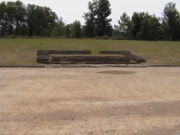
Stadium at Olympia
Encyclopedia

Olympia, Greece
Olympia , a sanctuary of ancient Greece in Elis, is known for having been the site of the Olympic Games in classical times, comparable in importance to the Pythian Games held in Delphi. Both games were held every Olympiad , the Olympic Games dating back possibly further than 776 BC...
is located to the east of the sanctuary of Zeus
Zeus
In the ancient Greek religion, Zeus was the "Father of Gods and men" who ruled the Olympians of Mount Olympus as a father ruled the family. He was the god of sky and thunder in Greek mythology. His Roman counterpart is Jupiter and his Etruscan counterpart is Tinia.Zeus was the child of Cronus...
. It was the location of many of the sporting events at the Ancient Olympic Games.
The stadium was a holy place for the ancient Greeks, as this is where sporting activities dedicated to Zeus were held. The stadium was originally located within the temenos
Temenos
Temenos is a piece of land cut off and assigned as an official domain, especially to kings and chiefs, or a piece of land marked off from common uses and dedicated to a god, a sanctuary, holy grove or holy precinct: The Pythian race-course is called a temenos, the sacred valley of the Nile is the ...
, with spectators able to view races from the slopes of Mt. Kronos. It was gradually relocated east until it reached its present location in the early 5th century BC. The stadium is connected with the sanctuary by a vaulted stone passageway.
The track is 212.54 m (697.3 ft) long and 28.5 m (93.5 ft) wide and surrounded by grassy banks on all sides. All the seats were made of mud and on the southern slope there was a stone platform, the exedra
Exedra
In architecture, an exedra is a semicircular recess or plinth, often crowned by a semi-dome, which is sometimes set into a building's facade. The original Greek sense was applied to a room that opened onto a stoa, ringed with curved high-backed stone benches, a suitable place for a philosophical...
, on which the Hellanodikai
Hellanodikai
The Hellanodikai were the judges of the Ancient Olympic Games, and the success of the games are attributed to their efforts. It was their sacred duty to maintain the standards and legacy of the games, as well as uphold the rules...
, the judges, would sit. Opposite this, on the north slope, was an altar to Demeter
Demeter
In Greek mythology, Demeter is the goddess of the harvest, who presided over grains, the fertility of the earth, and the seasons . Her common surnames are Sito as the giver of food or corn/grain and Thesmophoros as a mark of the civilized existence of agricultural society...
Chamyne. The stadium could hold 50,000 spectators.
During the 2004 Summer Olympics
2004 Summer Olympics
The 2004 Summer Olympic Games, officially known as the Games of the XXVIII Olympiad, was a premier international multi-sport event held in Athens, Greece from August 13 to August 29, 2004 with the motto Welcome Home. 10,625 athletes competed, some 600 more than expected, accompanied by 5,501 team...
, it hosted the shot put events
Athletics at the 2004 Summer Olympics
At the 2004 Summer Olympics, the athletics events were held at the Athens Olympic Stadium from August 18 to August 29, except for the marathons , the race walks , and the shot put...
.

